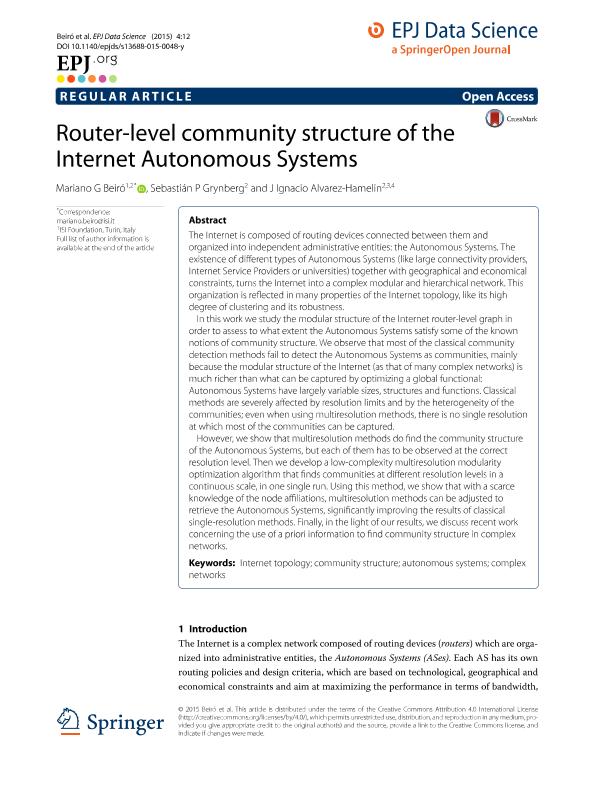Mostrar el registro sencillo del ítem
dc.contributor.author
Beiro, Mariano Gastón

dc.contributor.author
Grynberg, Sebastián P.
dc.contributor.author
Alvarez Hamelin, Jose Ignacio

dc.date.available
2017-04-03T20:39:27Z
dc.date.issued
2015-08
dc.identifier.citation
Beiro, Mariano Gastón; Grynberg, Sebastián P.; Alvarez Hamelin, Jose Ignacio; Router-level community structure of the Internet Autonomous Systems; Springer; EPJ Data Science; 4; 12; 8-2015; 1-22
dc.identifier.uri
http://hdl.handle.net/11336/14747
dc.description.abstract
The Internet is composed of routing devices connected between them and organized into independent administrative entities: the Autonomous Systems. The existence of different types of Autonomous Systems (like large connectivity providers, Internet Service Providers or universities) together with geographical and economical constraints, turns the Internet into a complex modular and hierarchical network. This organization is reflected in many properties of the Internet topology, like its high degree of clustering and its robustness. In this work we study the modular structure of the Internet router-level graph in order to assess to what extent the Autonomous Systems satisfy some of the known notions of community structure. We observe that most of the classical community detection methods fail to detect the Autonomous Systems as communities, mainly because the modular structure of the Internet (as that of many complex networks) is much richer than what can be captured by optimizing a global functional: Autonomous Systems have largely variable sizes, structures and functions. Classical methods are severely affected by resolution limits and by the heterogeneity of the communities; even when using multiresolution methods, there is no single resolution at which most of the communities can be captured. However, we show that multiresolution methods do find the community structure of the Autonomous Systems, but each of them has to be observed at the correct resolution level. Then we develop a low-complexity multiresolution modularity optimization algorithm that finds communities at different resolution levels in a continuous scale, in one single run. Using this method, we show that with a scarce knowledge of the node affiliations, multiresolution methods can be adjusted to retrieve the Autonomous Systems, significantly improving the results of classical single-resolution methods. Finally, in the light of our results, we discuss recent work concerning the use of a priori information to find community structure in complex networks.
dc.format
application/pdf
dc.language.iso
eng
dc.publisher
Springer

dc.rights
info:eu-repo/semantics/openAccess
dc.rights.uri
https://creativecommons.org/licenses/by/2.5/ar/
dc.subject
Internet Topology
dc.subject
Community Structure
dc.subject
Autonomous Systems
dc.subject
Complex Networks
dc.subject.classification
Otras Ciencias de la Computación e Información

dc.subject.classification
Ciencias de la Computación e Información

dc.subject.classification
CIENCIAS NATURALES Y EXACTAS

dc.title
Router-level community structure of the Internet Autonomous Systems
dc.type
info:eu-repo/semantics/article
dc.type
info:ar-repo/semantics/artículo
dc.type
info:eu-repo/semantics/publishedVersion
dc.date.updated
2017-04-03T17:29:35Z
dc.identifier.eissn
2193-1127
dc.journal.volume
4
dc.journal.number
12
dc.journal.pagination
1-22
dc.journal.pais
Alemania

dc.journal.ciudad
Berlín
dc.description.fil
Fil: Beiro, Mariano Gastón. ISI Foundation; Italia. Universidad de Buenos Aires. Facultad de Ingeniería; Argentina. Consejo Nacional de Investigaciones Científicas y Técnicas; Argentina
dc.description.fil
Fil: Grynberg, Sebastián P.. Universidad de Buenos Aires. Facultad de Ingeniería; Argentina
dc.description.fil
Fil: Alvarez Hamelin, Jose Ignacio. Consejo Nacional de Investigaciones Científicas y Técnicas. Oficina de Coordinación Administrativa Houssay. Instituto de Tecnologías y Ciencias de la Ingeniería; Argentina; Argentina. Instituto Tecnologico de Buenos Aires; Argentina. Universidad de Buenos Aires. Facultad de Ingeniería; Argentina
dc.journal.title
EPJ Data Science
dc.relation.alternativeid
info:eu-repo/semantics/altIdentifier/url/http://epjdatascience.springeropen.com/articles/10.1140/epjds/s13688-015-0048-y
dc.relation.alternativeid
info:eu-repo/semantics/altIdentifier/doi/http://dx.doi.org/10.1140/epjds/s13688-015-0048-y
Archivos asociados
